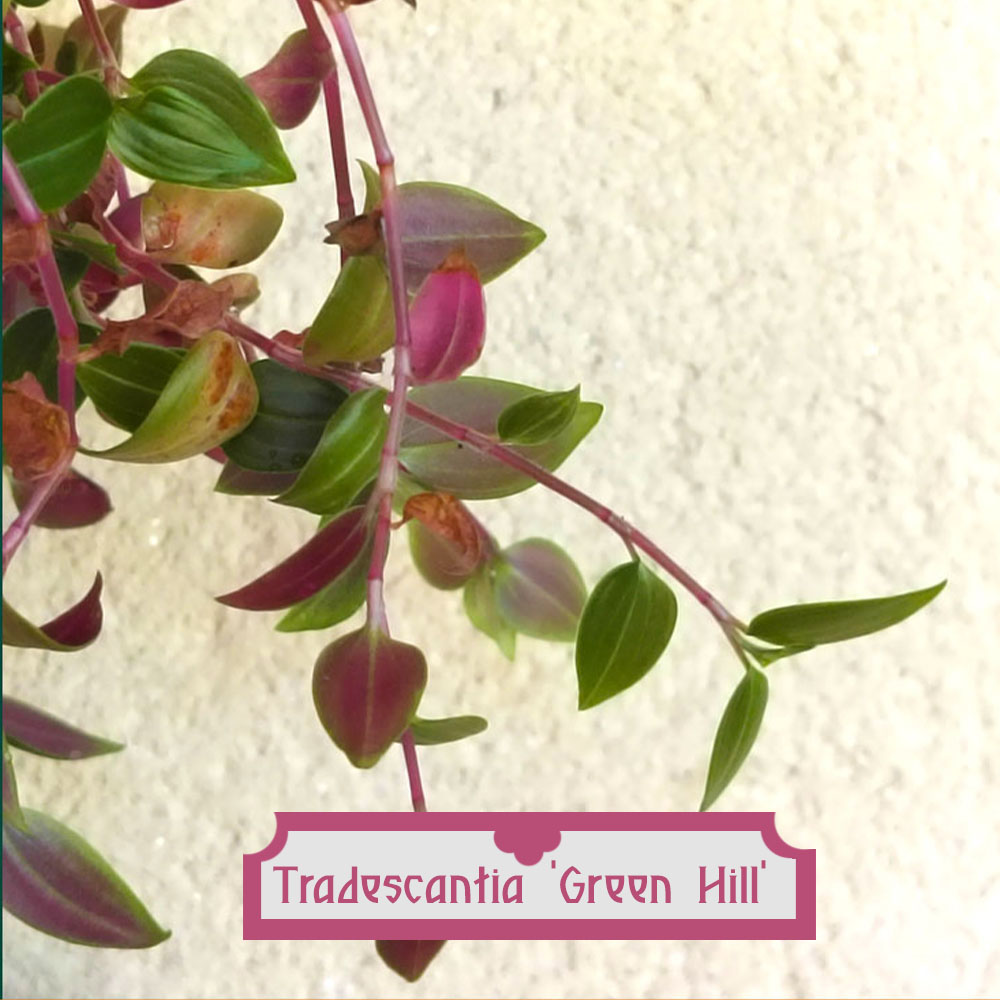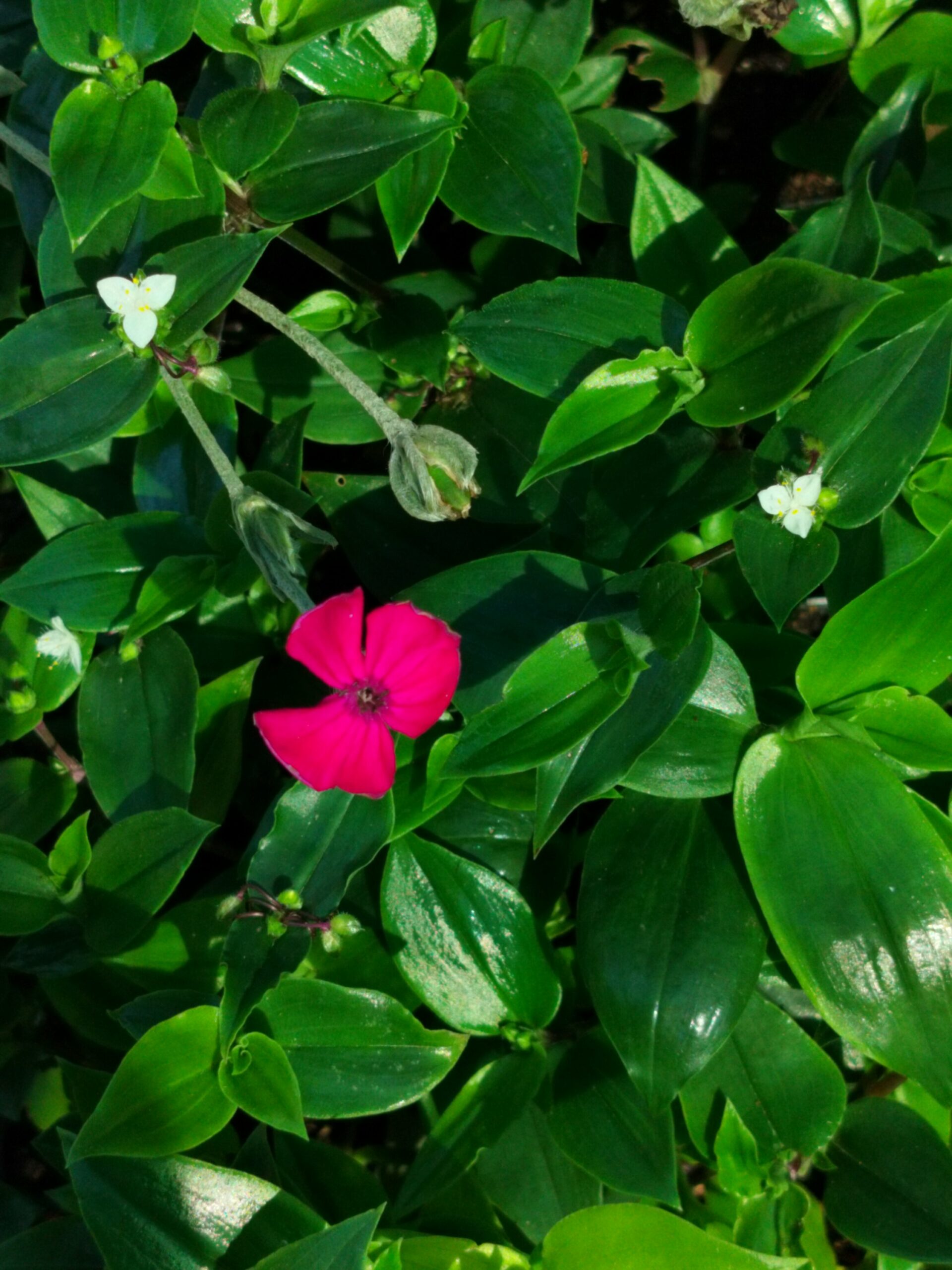No products in the cart.
Tradescantia Green Hill
Dark green and purple little leaves
Rated 0 out of 5
0 customer reviews
4,90 €
Only 18 item(s) left in stock!
SKU: pda71
Category: Balcony-Friendly, Better Indoors, Bouquet, Frost Hardy, Ground Cover, The Stunners

Tradescantia Green Hill
4,90 €
Only 18 item(s) left in stock!
Tradescantia Green Hill is a fast-growing perennial, with low creeping stems which will sprawl or trail out of containers.
It is magnificent in low light areas, remarkable for its drought tolerance and vigorous growth.
The leaves are small, ranging from light green to purple to golden, yellowish-green beneath – an optimization for low-light interiors.
Leaves are pointed ovals with a short narrow stalk between the sheath and the blade, 2-6cm long and 1.5-3cm wide. The lower and sometimes upper surfaces are covered with tiny bristly hairs.
The upper surfaces are greyish olive green to dark yellowish green. Lower surfaces are moderate yellowish green to dark purple with the veins contrasting in moderate yellow green. Leaf sheaths are moderate yellow green to greyish purplish red.
Leaves are pointed ovals with a short narrow stalk between the sheath and the blade, 2-6cm long and 1.5-3cm wide. The lower and sometimes upper surfaces are covered with tiny bristly hairs.
The upper surfaces are greyish olive green to dark yellowish green. Lower surfaces are moderate yellowish green to dark purple with the veins contrasting in moderate yellow green. Leaf sheaths are moderate yellow green to greyish purplish red.
Small flowers may appear all year round, but are rarely produced on indoor plants.
👨🌾GARDENING TIPS👨🌾:
-
- ☁️ In lower light, the stems can become slightly longer and thinner and sometimes they will drop their leaves > Prune and place in a touch more light.
- 🚿 It prefers warm temperatures and moderate humidity levels > bathrooms and kitchens with a small window are ideal.
- ✂️ Regular trimming maintains compact growth and encourages branching.
- Divide the bunch every 2 years as the growth is very vigorous and dense
- Easily propagated from cuttings year-round; rooting in water is highly effective > check out our step by step article on How to do Tradescantia cuttings. (this one is perfect for beginners)
- Tradescantia Green Hill works beautifully in mixed containers, as groundcover in rockeries, or cascading from raised planters – mix with Veronica spicata or Achillea Moonshine for cute indoor arrangements
- 🏠 Indoors – the foliage will remain the same throughout the winter season – and you may even get some winter blooming!
- 🌲 Outdoors – this variety is NOT frost hardy > bring her inside!
Learn more about the Tradescantia family:
The Tales & The Botany: Tradescantia Green Hill
Tradescantia mundula Green Hill was officially named in 2023
Tradescantia, commonly called spiderwort, is a genus in the Commelinaceae family, comprising around 75–90 species of perennial herbs.
Native to the Americas, especially Central and South America, these plants are prized for their vivid foliage and delicate, three-petaled flowers, making them favorites for borders, rockeries, and indoor displays.
The genus was named by John Tradescant the Elder, a 17th-century English botanist and gardener who introduced many North American plants to Europe.
In fact, Tradescantia was one of the first North American plants introduced to European gardens in the 17th century, and some cultivars are now so widespread they are considered naturalized in many temperate regions worldwide.
🌸Floral Morphology: Tradescantia Green Hill
Tradescantia Green Hill flowers are small, actinomorphic, and trimerous, with three light pink petals.
Flowers are borne in clusters (cymes) at the tips of stems and are short-lived, often opening for a single day but produced in succession to provide extended bloom.
Leaves are alternate, simple, and often lanceolate, with a succulent or slightly fleshy texture in some species. Many cultivars have variegated or purple-tinged foliage, adding ornamental value even when the plant is not flowering.
🍃Reproductive Biology
Tradescantia species are hermaphroditic, capable of self-pollination, though insects such as bees and hoverflies are the primary pollinators.
Fruits are capsular, splitting into three sections containing small seeds.
Some species also propagate readily via stem cuttings, which root easily in soil or water, making Tradescantia a favorite for vegetative propagation and indoor plant enthusiasts.
🌍Ecology & Adaptations
Tradescantia pallida var purpurea thrives in temperate to subtropical environments, so in France we’re limited to using them in:
-
- Container and indoor gardening: This is a perfect variety for container/indoor gardening as it trails, making it ideal for hanging baskets.
Key adaptations include:
-
-
Rapid vegetative growth.
-
Easy propagation
-
Moderate drought tolerance
-
Pest resilience
-
Foliage interest
-
Other Names
Baby Bunny Bellies
Origin:
Central and South America
| Weight | 0,5 kg |
|---|---|
| Flower Color | 🟣 Purple, 🩷 Pink |
| Exposure | Indirect Sun, Half Sun/Half Shade |
| Frost Tolerance | -1°C to -5°C |
| Size | 0.1m H x 0.6m W |
| Soil | Loam, Sandy, Well-Draining |
Reviews
0
Rated 0 out of 5
0 customer reviews
5
0
4
0
3
0
2
0
1
0
Only logged in customers who have purchased this product may leave a review.
Related Products
Melissa officinalis
A perennial plant in the mint family that is adored by bees, royal families and tea drinkers.
A perennial plant in the mint family that is adored by bees, royal families and tea drinkers.
Rated 0 out of 5
Erigeron kavinskianus
A daisy-like carpet of flowers
A daisy-like carpet of flowers
Rated 0 out of 5
Hieracium maculatum Leopard
A native perennial with blue-green leaves and a tall yellow flower
A native perennial with blue-green leaves and a tall yellow flower
Rated 0 out of 5
Hellebore argutifolius
Winter flowering perennial with marbled blue-green leaves
Winter flowering perennial with marbled blue-green leaves
Rated 0 out of 5
Tanacetum densum subsp amani
A shrublet composed of soft, finely divided silvery gray-white leaves.
A shrublet composed of soft, finely divided silvery gray-white leaves.
Rated 0 out of 5
Tradescantia Blushing Bride
Gorgeous blushes of pink and white that appear in the coldest nights.
Gorgeous blushes of pink and white that appear in the coldest nights.
Rated 0 out of 5
Artemisia Valerie Finnis
A semi-evergreen, aromatic variation on the theme of Artemisia.
A semi-evergreen, aromatic variation on the theme of Artemisia.
Rated 0 out of 5
Trachelospermum asiaticum ‘Ogon Nishiki’
Jasmine with colorful foliage and lovely white flowers in summer
Jasmine with colorful foliage and lovely white flowers in summer
Rated 0 out of 5
Cerastium tomentosum var. columnae
A grey-green spreading ground cover from the mountains.
A grey-green spreading ground cover from the mountains.
Rated 0 out of 5
Glechoma hederacea
A sweet smelling ground cover, producing little blue flowers all summer long.
A sweet smelling ground cover, producing little blue flowers all summer long.
Rated 0 out of 5
Vinca minor
Looping elegance and ability to form a low flowering ground cover
Looping elegance and ability to form a low flowering ground cover
Rated 0 out of 5
Echinacea purpurea
A perennial with purple flowers all summer long
A perennial with purple flowers all summer long
Rated 0 out of 5
Mentha x piperita ‘Chartreuse’
A spicy mint, known for its use in the production of liqueurs and herbal teas.
A spicy mint, known for its use in the production of liqueurs and herbal teas.
Rated 0 out of 5
Euphorbia myrsinites
Known for its draping form of silver-gray foliage and radiant blooms.
Known for its draping form of silver-gray foliage and radiant blooms.
Rated 0 out of 5
Stachys byzantina
Silky white-grey leaves and tall striking flowers
Silky white-grey leaves and tall striking flowers
Rated 0 out of 5
Kalanchoe daigremontiana
A toothy succulent from Madagascar, known as the Mother of Thousands.
A toothy succulent from Madagascar, known as the Mother of Thousands.
Rated 0 out of 5
Delosperma cooperi
A dwarf perennial known for its vermillion colored flowers
A dwarf perennial known for its vermillion colored flowers
Rated 0 out of 5
Sedum album
A low, multi-color ground cover.
A low, multi-color ground cover.
Rated 0 out of 5
recent view product
Sanguisorba minor
A delicate, fine leaved perennial with red flowers
A delicate, fine leaved perennial with red flowers
Rated 0 out of 5
Sedum Matrona
Big round leaves and soft pastel-pink flowers on long purple stems that flower for months.
Big round leaves and soft pastel-pink flowers on long purple stems that flower for months.
Rated 0 out of 5
Mentha x piperita ‘Chartreuse’
A spicy mint, known for its use in the production of liqueurs and herbal teas.
A spicy mint, known for its use in the production of liqueurs and herbal teas.
Rated 0 out of 5
Chrysanthemum Duchess of Edinburgh
A perennial that produces many burgundy red double flowers
A perennial that produces many burgundy red double flowers
Rated 0 out of 5
Vinca minor
Looping elegance and ability to form a low flowering ground cover
Looping elegance and ability to form a low flowering ground cover
Rated 0 out of 5












































There are no reviews yet.